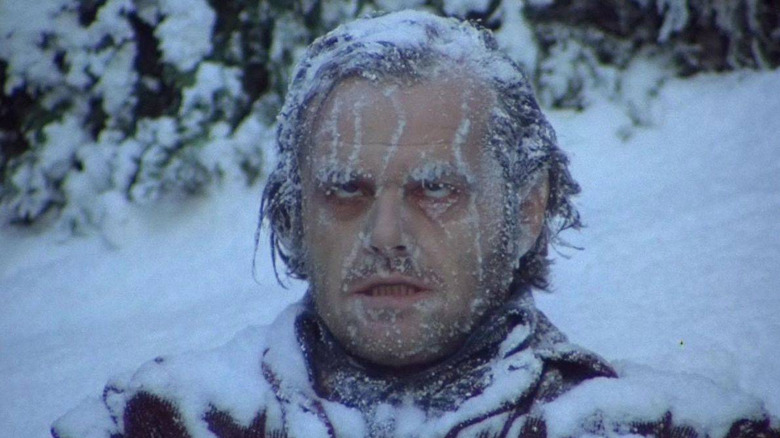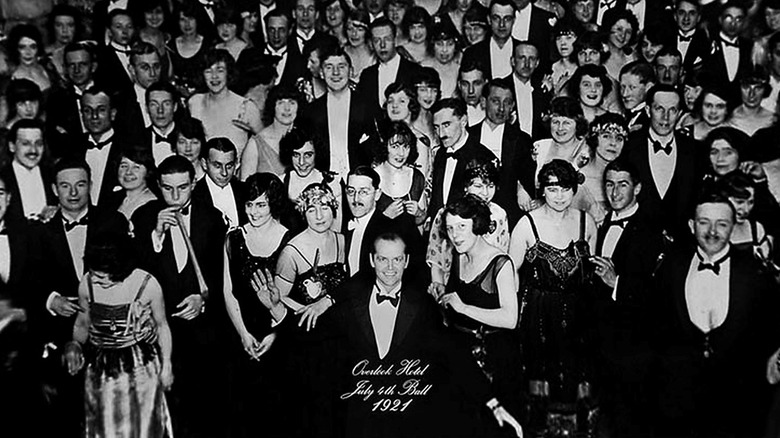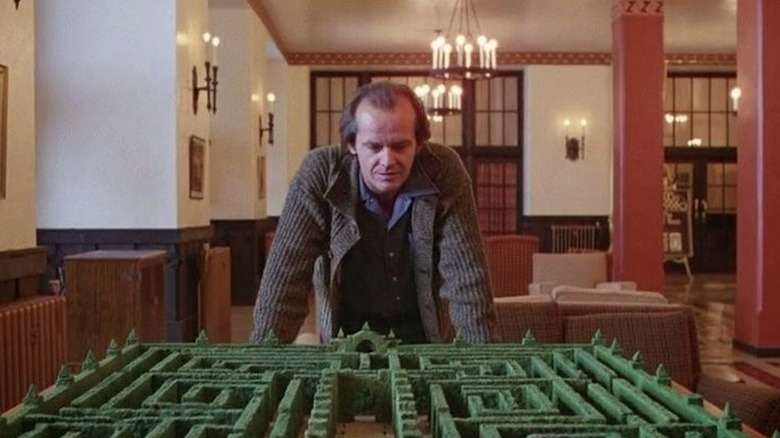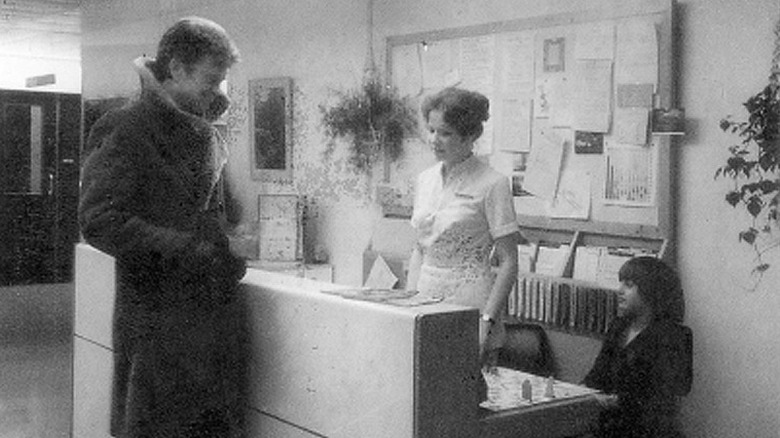The Shining Ending Explained: One Of The Most Famous Horror Conclusions Ever Deserves A Fresh Look
Perhaps no single film in the horror genre has been as closely analyzed, picked apart, and scrutinized as Stanley Kubrick's 1980 masterpiece "The Shining." Ostensibly an adaptation of Stephen King's 1977 potboiler of the same name, the film itself uses the same basic structure of the novel (troubled family become winter caretakers at a mountain hotel, dad goes crazy in the isolation, ghosts and alcoholism are involved) but takes some big left-field swings with the material in the third act. There's even a whole documentary called "Room 237" that dissects the film's symbology through the eyes of movie conspiracy theorists.
The ending itself has been of particular debate over the years, and was even altered by Kubrick AFTER the film's release. Let's dive into the enigma that is "The Shining," shall we?
What Happens...
The basic gist of the ending kicks off when, in the first moment of confirmed supernatural intervention in the film, the ghost of previous caretaker Delbert Grady (Philip Stone) inhabiting the Overlook Hotel sets Jack Torrance (Jack Nicholson) free from his confinement in the pantry freezer. Echoing the rampage of Grady from years prior, Jack begins running amok in the hotel, attempting to kill his family with an axe (a croquet mallet in the book). Cornering them in a bathroom, his wife Wendy (Shelley Duvall) helps son Danny (Danny Lloyd) escape through the window which she is too big to fit through. Jack chops through the door but Wendy fends him off with a knife.
Then Overlook chef Dick Hallorann (Scatman Crothers) arrives after sensing via "Shining" (King's term for ESP), and Jack heads off to murder him with the axe. He then pursues Danny into the hotel's outdoor hedge maze, and after hotly pursuing his boy's tracks, Danny fools his father by tracing backwards over his own tracks and then escaping. Jack is misled through the maze, and winds up lost in the freezing cold. As Wendy and Danny escape in the snowcat that Hallorann brought with him, Jack slumps down amid the freezing maze, exhausted and muttering. A jump cut shows him the next morning completely frozen, literally stone cold dead.
The final shot has the camera gliding through The Gold Room out into the hallway where rows of photographs from the hotel's past are hung. It hones in right at the photo in the center, which depicts a massive July 4 ball at the Overlook in 1921, with Jack Torrance front-and-center, smiling almost maniacally right into the camera as "Midnight, the Stars & You" by Henry Hall & The Gleneagles Hotel Band plays hauntingly into the credits. As horror filmmakers have practiced time and time again, there's nothing like old music by dead people to set a mood.
What it Means...
The key to understanding the ending lies in Grady's ominous portent to Jack in the bathroom midway through the film: "You are the caretaker. You've always been the caretaker. I should know, sir... I've always been here." In essence, the Overlook Hotel has some kind of bad juju about it that makes it a center of supernatural activity. Perhaps it's the fact that it was contaminated by the actions of "all the best people" that stayed there over the years, the rich and powerful, movie stars and royalty. It could also be that when it was built between 1907 and 1909 it happened to be on top of an ancient Native American burial ground, with the builders having to "fight off a few Indian attacks while they were building it"... you know, that old chestnut?
What do the spirits that inhabit the place want? Souls, of course. How does it get them? By influencing those that are most unstable and vulnerable, like poor recovering alcoholic Jack Torrance, or Grady for that matter. Influencing them to murder, to claim souls on behalf of the hotel. Grady succeeded in killing his children, whose corpses Danny sees scattered in the hallway, thus he and they are "claimed" by the hotel "forever... and ever... and ever." Wendy and Danny managed to escape, but Jack did not, thus he becomes part of the hotel itself, past and present. The next poor SOB to take the job of winter caretaker may just have an encounter with Jack dressed in coat and tails in the hotel bathroom.
This ending has many differences from the novel, chiefly the climax which involves hedge animals coming to life instead of a hedge maze, something that with 1980 technology would have looked rather ridiculous. King's ending also has the boilers exploding from neglect and the Overlook burning down as Wendy, Danny and a very much alive Dick Hallorann escape. A literal pyrrhic victory.
"The ending was changed almost entirely because Kubrick found it a cliche to just blow everything up," the film's co-screenwriter Diane Johnson told Entertainment Weekly. "He thought there might be something else that would be metaphorically and visually more interesting."
By leaving the Overlook "alive" at the end of the film, Kubrick was able to ensure its menace would not be diminished in the audiences mind. The idea of killing off Dick was also done to raise the dramatic levels of the story and heighten the horror. At one point killing Danny was even discussed, with Kubrick imagining a small chalk outline of the boy's body on the hotel floor, but cooler heads prevailed.
Kubrick's Original Ending
A crucial scene right at the end of "The Shining" was infamously deleted after the first week of previews in New York and Los Angeles. It takes place after the shot of Jack frozen, and finds Wendy and Danny recovering from their traumatic experience in a hospital. Stuart Ullman (Barry Nelson, actually the first actor to play James Bond in a television show in 1954!) comes to visit the two to let them know that no evidence of the supernatural was found. Then, in a haunting callback, Ullman tosses Danny the same yellow tennis ball that was rolled to him in the hallway at the hotel.
"The tennis ball is the same thing as the photograph — it's unexplainable," producer Jan Harlan told EW. "It makes Ullman now another ghost element. Was he the ghost from the very beginning? The film is complex enough because nothing is explained... When the film [screened for critics] and wasn't well received, Warners quite rightly suggested, 'It's enough, just take [the hospital scene] out.' So Stanley did it. He's not stubborn, especially since this is a film mainly to entertain people. But Stanley was actually very sad that he misread the audience, that he trusted the audience to live with puzzles and no answers, and that they didn't like it."
Would this extra coda have made the film scarier? Would it have explained too much? Been more confusing? It's hard to tell, since all copies of this ending were destroyed at Kubrick's request. At least Stanley got the ending he wanted.



